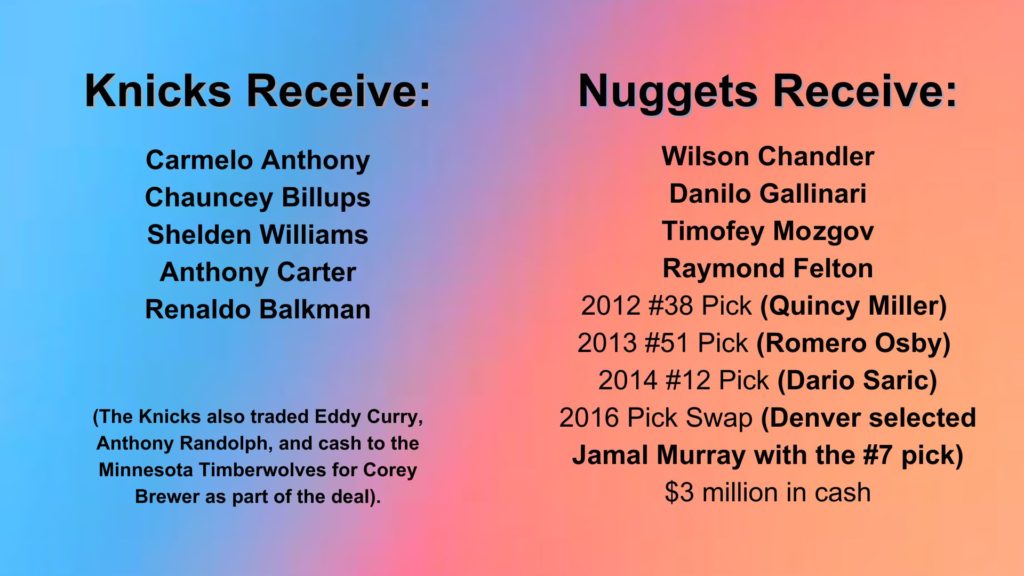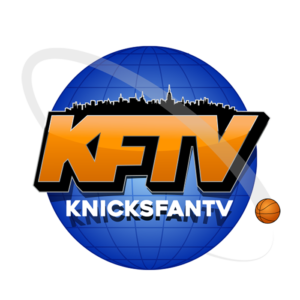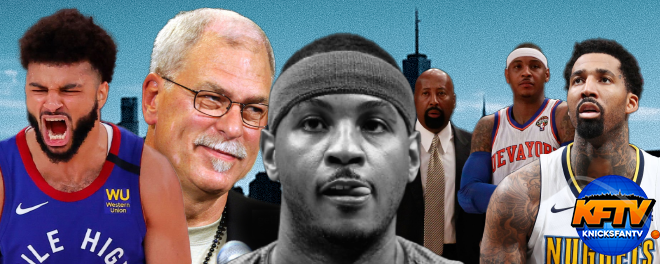Carmelo Anthony is easily one of the best players in Knicks’ history. But was the trade that brought him to New York a success or failure?
Discussions surrounding Carmelo Anthony and his Knicks legacy have increased since he announced his retirement from the NBA on May 22nd. Most of the conversations have been positive, considering Melo is one of the league’s best scorers ever and successfully embraced the weighty burdens of the orange and blue jersey.
Some of the discourse, though, has been unfair, incomplete, and riddled with the privilege of hindsight. Just about every Knicks fan had their eyes glued to the screen when Skylar Grey sang “I’m Coming Home” before the Brooklyn native made his Knicks debut versus the Milwaukee Bucks on February 23rd. And yet, people have the nerve to question that moment.
Well, there is a good reason for doing so. The Melo era had its highs (#Knickstape) but mainly featured disappointing years and broken promises. Twelve years later, it is important to reevaluate the trade for the superstar as the current Knicks team faces a relatively similar crossroads.
Did New York make the right decision to mortgage their assets midseason to acquire Anthony? Did Melo put the Knicks back on the map? Or did he ruin the rest of the franchise’s 2010s?
Without further ado, let’s revisit the Carmelo Anthony trade…
Trade Details

Context
The Knicks made the Conference Finals in 2000 before losing to an Indiana Pacers team that would get dunked on by Shaq for six straight games en route to The Diesel’s first ring. From 2001-2010, New York had a record of 327-493, tied for the fourth worst in the league with the Hawks during that span. The Knicks made the first round of the playoffs twice and nothing more.
The best players from the post-Ewing dark ages were Allan Houston, Latrell Sprewell, Marcus Camby, Stephon Marbury, Jamal Crawford, and David Lee (and shout out to Nate Robinson’s all-star weekend slam fests as well). Like laundry, the Knicks cycled through washed stars—Penny Hardaway, Tracy McGrady, and Steve Francis. Dolan kicked front office heads out the door like DJ Jazzy Jeff. The Steph Curry whiff epitomized their draft luck. Isiah Thomas invested in Eddy Curry. The franchise needed saving.
When the Knicks struck out on the Heatles (LeBron James, Dwyane Wade, and Chris Bosh), Amar’e Stoudemire was the Summer 2010 consolation prize. He played very well, igniting the Garden with 17 30+ point games before Melo arrived. Surrounding him were promising young players like Danilo Gallinari, Wilson Chandler, and Landry Fields. The team hovered near .500 heading into the All-Star break. Then, the trade became official.
Did the Knicks give up too much?
The trade had a structure similar to more recent blockbusters around the league. Of course, teams were much more frugal with draft picks back then. But still, three young players, one veteran, two first-rounders, and two second-rounders for a midseason rental feels like a haul we could see Portland, for example, receive next February when they (finally) decide on a Damian Lillard divorce.
In the summer of 2019, Anthony Davis was traded to Los Angeles for Brandon Ingram, Lonzo Ball, Josh Hart, and four first-rounders (2019, 2022, 2023, and 2024). Like Melo, the deal was contingent on Davis’ agreement to an extension with his new team. Both were top 5-10 players in the league when dealt. With AD and LeBron, the Lakers had a title contender. With Melo and Amar’e, the Knicks had some hope, reincarnated relevance, and justification for high ticket prices.
The former Knicks in the Melo deal were essential pieces of a 2010-11 team that performed better than any other team since 2000-01. Chandler was a young athletic forward. Despite the injuries, Gallinari showed promise as a modern-day tall shooter. Felton was solid. Mozgov gave good value as an undrafted player. None of these guys were stars, but like Felton in 2013, all had the potential to be reliable contributors in their roles on a good team, as they ended up being for the Nuggets.
Watching Jamal Murray light up Staples Center Crypto.com Arena in the Conference Finals may hurt to see, but who knows what would’ve happened had the Knicks kept their draft picks. Would they have gone 32-50 in 2016? How would the no-trade have affected the records and pick swap? And would the Knicks’ scouting team have made the right decisions?
For reference, here are some notable players available with the picks New York traded to Denver:
2012: Khris Middleton (#39) and Will Barton (#40) 2013: No one notable 2014: Zach LaVine (#13), T.J. Warren (#14), Jusuf Nurkić (#15), Clint Capela (#25), Bogdan Bogdanović (#27), Kyle Anderson (#30) 2016: Jakob Poeltl (#9)*, Domantas Sabonis (#11), Malik Beasley (#19), Caris LeVert (#20), Pascal Siakam (#27), Dejounte Murray (#29), Malcolm Brogdon (#36) *The Knicks took Cleanthony Early with the #34 pick in 2014 over Spencer Dinwiddie, Jerami Grant, Nikola Jokić, and Jordan Clarkson. **The Knicks traded away the #9 pick to Toronto in exchange for Andrea Bargnani.
The butterfly effect is more than just a movie starring Ashton Kutcher. There’s no way of knowing what would have happened if the Knicks didn’t trade for Melo. Gallo could’ve become an all-star, or he could’ve flopped. The Knicks could’ve taken Murray (either of them)…or Thon Maker. Instead, they made a wise decision in going for the sure thing in Carmelo Anthony.
Wouldn’t he have signed there in the offseason anyway?
This is the most intriguing aspect of the trade, and the part that aggravated New Yorkers will probably scream verbatim: How come Melo wouldn’t just sign with the team in the offseason? The Knicks had the cap space! Why’d they gut their depth for the guy?
It’s a great point: trading Gallo, Chandler, Felton, Mozgov, and four draft picks put the franchise in a tough spot to fill out the roster. But, for what it’s worth, the front office did a great job recovering by acquiring newly championed Tyson Chandler and Jason Kidd, drafting Iman Shumpert, trading for Felton, and picking up free agents J.R. Smith and Kenyon Martin midseason, all within two years to curate the 2012-13 squad that gave us so many joyous memories.
Now, imagine what they could’ve done and the flexibility they would’ve had if they were able to keep Gallo and Chandler as well as the draft capital. Perhaps, if Melo was fully committed to forcing his way to New York, just as Anthony Davis was to Los Angeles, or if he was just a little more patient and signed in the offseason, the #Knickstape era could’ve lasted a few more years.
But that’s also the issue with this selective hindsight on the trade. Carmelo Anthony wasn’t exactly wearing a “That’s All, Folks!” t-shirt on his way to games in Denver, and his agent wasn’t Rich Paul (ironically, it was Leon Rose). Throughout the 2010-11 season, his future was essentially a mystery, even if New York was reported to be a preferred destination.
According to this ESPN article, Chicago, Houston, and New Jersey were on his initial wish list when he made an informal trade request before the 2011 season. More teams were eyeing him, too. There’s also this nugget of information per another ESPN article on the trade:
“He stood to become the headliner of the 2011 free-agent class but didn't want to risk free agency knowing a new collective bargaining agreement could cost him millions.”
[Note: he was probably right. The lockout happened the following season]
Thus, a trade for Anthony would’ve meant securing him for three additional years for around $65 million. However, if Melo really couldn’t stand Denver and his eyes set on teaming up with Stoudemire, his friend, in New York from the start of 2010-11, an official demand for his destination may have saved New York some assets.
Instead, Melo tried to walk an imaginary line of professionalism in the wake of mass scrutiny about LeBron’s ‘Decision.’ His effort in Denver, if you could call it that, had already shown his true feelings. But it was a different era. Player empowerment and leverage weren’t quite as prominent as it is today. We can’t evaluate yesterday’s events with today’s standards.
And now, can you genuinely blame the Knicks for making the move? If Jaylen Brown became available at the trade deadline next season, how many fans would push for New York to make the move? Of course, the circumstances (cap space and expectations) are different. Still, the principles are the same: if an All-NBA player is available, it’s difficult to pass up on that opportunity.
For reference, the Chicago Bulls finished the 2010-11 season with a 62-20 record, the youngest MVP in league history (Derrick Rose), and a very good coach (Thibs!). The Nets had similar assets to the Knicks and planned to move to Brooklyn soon. Houston was also gearing up for a big move—they traded for James Harden in the following offseason. New York had competition for Melo. If they let him hit free agency, they’d risk missing out on another all-timer.
One could argue that Melo’s refusal to force his way out of Denver put the Knicks in a spot where they had to gut their depth to overcome the uncertainty. I don’t blame him for not committing to a decision—he publicly claimed: “My options are open.” But I also don’t blame New York for pouncing on the chance to acquire the franchise’s best player since Ewing, either.
If we’re going to do the hindsight hypothetical stuff, let’s at least be honest about the entirety of the situation. The Melo era didn’t turn out the way we would’ve hoped, but the trade had less to do with that fact than you might think.
Verdict: Good trade, would do it again.
Grade for Knicks: B+
We’ve seen this story time and time again. The Knicks missed out on Kevin Durant and Kyrie Irving, and Julius Randle, like Amar’e, became the prize of the summer. Now, the Knicks face a decision regarding trading their assets in exchange for whatever all-star becomes available in a few weeks. The front office already held their ground during the Donovan Mitchell negotiations. Will that change this time around? And how will these decisions look when we reflect on it a decade later?
Bonus: The real downfalls
If you want something or someone to blame for the failures of the 2010s Knicks, I’ve listed some options to add to your Burn Book. Here are the real villains (order them as you please):
- Andrea Bargnani
- The Triangle Offense
- Swing-and-miss on Chris Paul in 2012
- J.R. Smith’s suspension for Game 4 against the Celtics in 2013
- A Torn ACL (Kristaps Porzingis)
- The firing of Coach Mike Woodson
- Roy Hibbert
- The failed superteam of 2016
- Joakim Noah’s contract
- A fire extinguisher (and whatever else caused Stoudemire’s injuries)
- Masai Ujiri (who traded Bargnani to the Knicks)
- Phil Jackson and his raw octopi
- J.R. Smith’s Game 1 versus the Pacers in 2013
- The Chauncey Billups amnesty
- The Dolan/MSG vs. Oakley incident
Stay tuned to KnicksFanTV.com for the latest Knicks news, rumors, and recaps throughout the NBA season. And in case you missed it, check out Fred Katz’s special guest appearance on KFTV, where he answers Knick fans’ mailbag questions.












